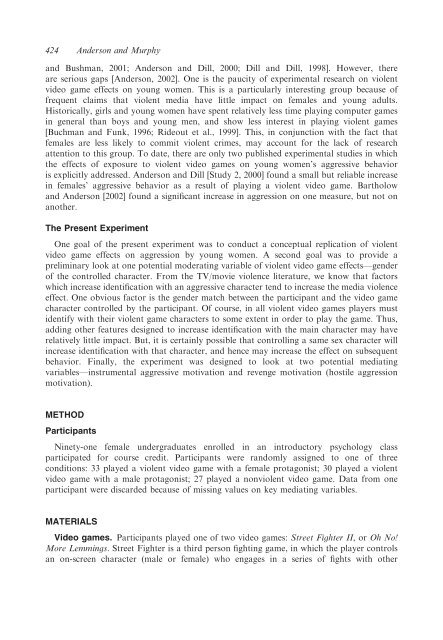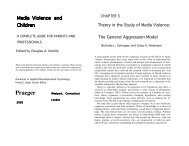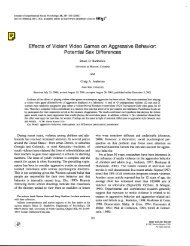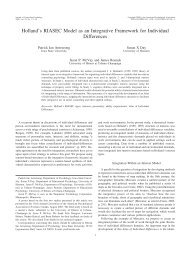Violent Video Games and Aggressive Behavior in Young Women
Violent Video Games and Aggressive Behavior in Young Women
Violent Video Games and Aggressive Behavior in Young Women
Create successful ePaper yourself
Turn your PDF publications into a flip-book with our unique Google optimized e-Paper software.
424 Anderson <strong>and</strong> Murphy<br />
<strong>and</strong> Bushman, 2001; Anderson <strong>and</strong> Dill, 2000; Dill <strong>and</strong> Dill, 1998]. However, there<br />
are serious gaps [Anderson, 2002]. One is the paucity of experimental research on violent<br />
video game effects on young women. This is a particularly <strong>in</strong>terest<strong>in</strong>g group because of<br />
frequent claims that violent media have little impact on females <strong>and</strong> young adults.<br />
Historically, girls <strong>and</strong> young women have spent relatively less time play<strong>in</strong>g computer games<br />
<strong>in</strong> general than boys <strong>and</strong> young men, <strong>and</strong> show less <strong>in</strong>terest <strong>in</strong> play<strong>in</strong>g violent games<br />
[Buchman <strong>and</strong> Funk, 1996; Rideout et al., 1999]. This, <strong>in</strong> conjunction with the fact that<br />
females are less likely to commit violent crimes, may account for the lack of research<br />
attention to this group. To date, there are only two published experimental studies <strong>in</strong> which<br />
the effects of exposure to violent video games on young women’s aggressive behavior<br />
is explicitly addressed. Anderson <strong>and</strong> Dill [Study 2, 2000] found a small but reliable <strong>in</strong>crease<br />
<strong>in</strong> females’ aggressive behavior as a result of play<strong>in</strong>g a violent video game. Bartholow<br />
<strong>and</strong> Anderson [2002] found a significant <strong>in</strong>crease <strong>in</strong> aggression on one measure, but not on<br />
another.<br />
The Present Experiment<br />
One goal of the present experiment was to conduct a conceptual replication of violent<br />
video game effects on aggression by young women. A second goal was to provide a<br />
prelim<strong>in</strong>ary look at one potential moderat<strong>in</strong>g variable of violent video game effects—gender<br />
of the controlled character. From the TV/movie violence literature, we know that factors<br />
which <strong>in</strong>crease identification with an aggressive character tend to <strong>in</strong>crease the media violence<br />
effect. One obvious factor is the gender match between the participant <strong>and</strong> the video game<br />
character controlled by the participant. Of course, <strong>in</strong> all violent video games players must<br />
identify with their violent game characters to some extent <strong>in</strong> order to play the game. Thus,<br />
add<strong>in</strong>g other features designed to <strong>in</strong>crease identification with the ma<strong>in</strong> character may have<br />
relatively little impact. But, it is certa<strong>in</strong>ly possible that controll<strong>in</strong>g a same sex character will<br />
<strong>in</strong>crease identification with that character, <strong>and</strong> hence may <strong>in</strong>crease the effect on subsequent<br />
behavior. F<strong>in</strong>ally, the experiment was designed to look at two potential mediat<strong>in</strong>g<br />
variables—<strong>in</strong>strumental aggressive motivation <strong>and</strong> revenge motivation (hostile aggression<br />
motivation).<br />
METHOD<br />
Participants<br />
N<strong>in</strong>ety-one female undergraduates enrolled <strong>in</strong> an <strong>in</strong>troductory psychology class<br />
participated for course credit. Participants were r<strong>and</strong>omly assigned to one of three<br />
conditions: 33 played a violent video game with a female protagonist; 30 played a violent<br />
video game with a male protagonist; 27 played a nonviolent video game. Data from one<br />
participant were discarded because of miss<strong>in</strong>g values on key mediat<strong>in</strong>g variables.<br />
MATERIALS<br />
<strong>Video</strong> games. Participants played one of two video games: Street Fighter II, orOh No!<br />
More Lemm<strong>in</strong>gs. Street Fighter is a third person fight<strong>in</strong>g game, <strong>in</strong> which the player controls<br />
an on-screen character (male or female) who engages <strong>in</strong> a series of fights with other
















